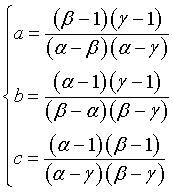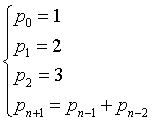
The search for a sequence of natural numbers such that the ratio between each of them and the previous one converges to the plastic number was also made by the architect Richard Padovan who discovered that the sequence pn generated by

has the same behavior as the Perrin sequence. This sequence is said Padovan sequence and its terms Padovan numbers.
Padovan numbers pi can be deduced as follows.



This definition of pi implies

because as the exponent approaches the infinity, the powers of β and γ converge to 0.
Moreover you have
![]()
that is
![]()
Infact

The use of the recursive definition for the computer calculation of the n-th Padovan number is impractical. Better to use a loop, as in the following Javascript implementation
function nPadovan(n)
{
n = parseInt(n);
if (n < 2) return 1;
var n1 = 1;
var n2 = 1;
var n3 = 1;
var p;
for (var i=3; i<=n; i++)
{
p = n2 + n3;
n3 = n2;
n2 = n1;
n1 = p;
}
return(p);
}
If you can use Mathematica (Wolfram), you may define the following function
PadovanN[n_]:=Switch[n,0,1,1,1,2,1,_,Module[{i,n1,n2,n3,val},n1=1;n2=1;n3=1;
For[i=3,i <= n,i++,val=n2+n3;n3=n2;n2=n1;n1=val];val]]
Table[PadovanN[n],{n,0,30}]
{1,1,1,2,2,3,4,5,7,9,12,16,21,28,37,49,65,86,114,151,200,265,351,465,616,816,1081,1432,1897,2513,3329}
In general, any sequence of numbers qi expressed as a linear combination with coefficients a, b, c of the i-th powers of the roots α, β and γ, given three arbitrary values for q0 , q1 and q2, shows the same recursion and the ratio between each term and the previous one converges to P.
For example, the sequence

that is
| 1 | 2 | 3 | 3 | 5 | 6 | 8 | 11 | 14 | 19 | 25 | 33 | 44 | 58 | 77 | 102 | 135 | 179 | 237 | ... |
is such that
